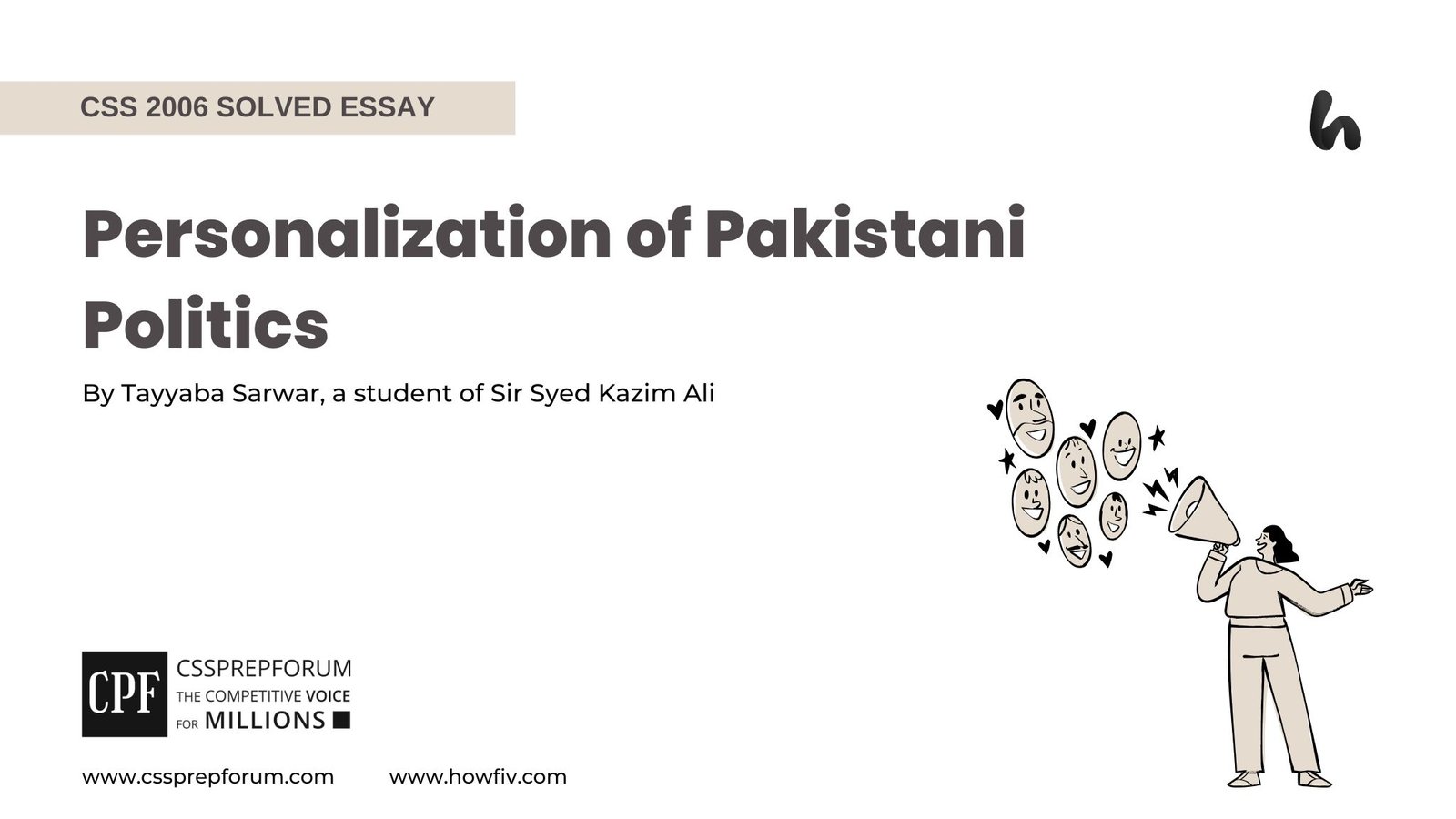CSS 2021 Solved Current Affairs Past Papers | Should New Provinces be Created or Not?
The following question of CSS Current Affairs 2021 is solved by Sir Ammar Hashmi, the best Current Affairs Coach, on the guided pattern of Sir Syed Kazim Ali, which he taught to his students, scoring the highest marks in compulsory subjects for years. This solved past paper question is uploaded to help aspirants understand how to crack a topic or question, how to write relevantly, what coherence is, and how to include and connect ideas, opinions, and suggestions to score the maximum.

Question Breakdown
This question has one part. It requires us to analyse the background that major political parties have committed to creating new provinces in Pakistan and then conclude by referring to the new province debate on whether new provinces should be created or not.
Outline
1-Introduction
2-Situational Analysis to the creation of new provinces in Pakistan
3-Why is the creation of new provinces important?
4-Featured Benefits of Creating New Provinces
5-Possible proposed provinces
6-Prospects and Challenges in the creation of new provinces of Pakistan
7-Critical Analysis
8-Conclusion

Answer to the Question
Introduction
The governing system all over the world is diversified with reference to the political system of every country. Some countries are a complete region with no ethnic or cultural differences to govern, whereas some have formed small administrative units or provinces to govern one’s country. Pakistan has had governance problems for years, so the demand for creating a new province became compulsory so that the authorities could be passed down to the lower level and problems of the public could be solved at their thresholds. There are several reasons why the plan for new provinces is not being executed. So much so, there are some relevant solutions to the hurdles as well.
Situational Analysis to the Creation of New Provinces in Pakistan
Before jumping up to the importance of new provinces, some situational facts are required to understand the matter behind the creation of new provinces. Pakistan, with a largely spread landscape of 796096 sq. km geographical area, has only four provinces, whereas Turkey, with a geographical area of 783 562 sq. km, have eighty-one provinces. The same is the case with Pakistan’s neighbouring country, India, with 36 small administered provinces and 29 states. Western Punjab of India was further divided into Haryana and Himachal Pradesh in 1966. Iran has 31 provinces, China has 34, Afghanistan has 34, Sri Lanka has 9, and Bangladesh has eight administrative units. According to the Global Prosperity Index 20203, Pakistan stood at 136th among the 146 countries on the list of the world’s most prosperous nations. This indicates the growing disparity on the economic and social level, overshadowed by a lack of political leadership to govern the vast landscape of Pakistan.
Why the creation of new provinces is important?
- An Historical Overview
To find the reason behind the importance, we have to dig down into the tapestry of the 1947 partition. Along with West and East Pakistan, 13 other princely states joined Pakistan decisively, including Bahawalpur and Khairpur—Makran, Kalat, Lasbela, Hunza, Swat and other states. Soon after independence, India realized good governance could be enacted by creating small administrative units. Therefore, it adopted an administrative division system and currently, India has 28 states and eight Union territories. This working process started in 1958 in India, whereas in Pakistan, this process has been limited only to political slogans and claims. In the Global Governance Index, India ranks 68th while Pakistan ranks 144th. Bangladesh, being smaller in size and population than Pakistan, is divided into eight administrative units.
- In terms of Area
If we cast a deep glance at the provinces of Pakistan, Punjab, being the most populous province, comes first with more than 11 crore of population and 200,000 sq. km of area, which means it is larger than 194 countries among 206 in terms of population and greater than 120 countries in terms of geography. Baluchistan, being the largest province of Pakistan, is greater than 143 countries of the world with an area of 347,000 sq. km.
Due to the non-formation of new provinces, questions are being raised about the fair distribution of resources. Many areas, such as Baluchistan, South Punjab, and Central Sindh, lagged in development, and the native population couldn’t get its fair share in employment, infrastructure, education, health, and human development. Despite the immense resources, the country cannot join the ranks of first-world countries.
Featured Benefits of Forming More Provinces
- Balancing Federation:
It will help balance the federation. In a sense, Punjab, with 53% of the population, possesses the greater share in NA for seats, which has created an imbalance in the equal distribution of power, and grievances of smaller provinces remain unresolved. By creating more provinces, the burden of the federation will be distributed more instead of only relying on Punjab.
- Decentralization and Good Governance:
Decentralizing the authority will help reach the lower level of the public, where a common man could easily approach government institutes. For example, Multan is 200 km away from Lahore, Karachi 600 km away from Kashmor, and Quetta 1000 km from Gwadar to reach the high court. Democracy will ultimately suffer. New provinces will decentralize the power and build more capital in the approaching range of an ordinary man.
- Localization of funds:
The creation of new provinces will help in the optimal allocation of funds. New provinces will lead to the localization of funds and smoothen the development process.
- More capital centres:
Cities and divisions play a vital role in the country’s economic growth. With a 35% share of Tokyo in Japan’s growth, Paris has more growth for France. The more capital there is, the more growth the economy will be triggered. There is no urban centre in rural areas or backward areas of the country like Fata. It will also help to balance the job ratio. It will reduce the migration rate as well as balance the literacy rate of the population. For this, the funds of Karachi would be allocated according to the locality of the city; if more migrants come to live there, then the allocation of funds will become difficult, and as estimated, by 2070, Pakistan’s major chunk of the population will become urban-centred for which new provinces are required to be formed.
How many provinces can possibly be created?
- Role of National Commission in forming new provinces
First and foremost, it is necessary to form a national commission, of which the electable and representatives of all relevant sectors should be part. If we look at Pakistan’s population, area, and administrative division, then according to various experts, Pakistan should have 14 to 16 provinces.
- Division of Punjab
In this regard, Punjab has to be divided into 5 to 6 parts. One of the suggestions is that Rawalpindi, Gujranwala and Gujrat divisions should be merged to form a single province. In another case, Rawalpindi should be made a separate province of Potohar, and another province comprising Gujrat and Gujranwala should be made. Faisalabad and Sargodha divisions are proposed to be merged into one. Similarly, the Lahore division can be merged with the Okara District of Sahiwal Division to form a separate province. Multan, DG Khan and the remaining districts of Sahiwal division can be combined to form Multan Province. Likewise, Bahawalpur can be restored to the status of a separate state as the state of Bahawalpur is a vast division which is spread over 46000 sq. km with a population of around 12.5 million.
- Division of Sindh
Now, if we turn to Sindh Province, the Karachi division can clearly be given the status of a separate state, while Sukkhar, Larkana and Shaheed Benzairabad can also be merged as one unit. In the third last proposed province of Sindh, the divisions of Hyderabad, Bhanbhor and Mirpur can be added.
- Division of Baluchistan
Baluchistan province can be divided into two separate provinces: Kalat, Makran, and Rukhshan. The division of Quetta, Zhob, Loralai, Sibi, and Naseerabad may become a second province.
- Division of Khyber Pakhtunkhwa
Khyber Pakhtunkhwa province also has the capacity for three more provinces in which one province can be formed by combining the DI Khan and Bannu divisions. In the second province, the divisions of Mardan, Peshawar, and Kohat can be given the status of separate provinces. A third province can be formed by merging Hazara and Malakand, the northern divisions of the province. Gilgit Baltistan has been given the status of a province, but some constitutional issues have yet to be resolved.
- Status of South Punjab
Some necessary steps have been taken for the province of South Punjab. Its separate secretariat is being formed, and the process of bifurcating the bureaucracy is underway. However, to give it the status of an individual state, some constitutional amendments still need to be made. At least a two-thirds majority is required to amend the constitution, which no political party has been getting from the last several elections. The talk of the new province constantly looks like politics and self-interests.
Prospects and Challenges in the creation of new provinces of Pakistan
The creation of new provinces will not be easy. Especially in a country like Pakistan, where the nation is already in a state of ethnic and linguistic turmoil and lack of political interests, there are some active challenges to be faced.
- Constitutional Challenges:
The foremost challenge is a constitutional amendment, for which parliament has to gain a two-thirds majority from both houses to amend the constitution under Article 239. The consent of the provincial assembly is another challenge, as all four provinces are ruled by local masses-based political parties who have their separate interests to advance.
- Distribution of Resources:
The distribution of resources is another hurdle to cross over. The federal government collects all the revenue, and there has always been a kind of conflict between the provinces. The distribution of resources is a contentious issue between the provinces. Majorly, Baluchistan and KPK pose the objection and the Kashmir region that Punjab has consistently been awarded a greater number of resources that do not belong to the landscape of Punjab. There has always been an objection over the National Finance Commission Award for discriminating between other provinces in Punjab. The division of rivers is also an active issue between the provincial and the federal government.
- Economic Challenges:
There are also some economic challenges, as the creation of new provinces will also affect the economy. The proponents of this amendment believe that the creation of more provinces will allocate the budget more effectively as the major portion of the budget would be allocated to the under-developed areas as per their needs and demands. On the other hand, where South Punjab, with the largest producer of cotton, would expect to have more textile industry and KPK may own hydroelectric power projects more, this may impose the larger portion of tax to be borne by a province alone which will add up in non-development expenditures. The government has to develop an effective plan for administrating the creation of new provinces while keeping these complications in view.
Critical Analysis
Analyzing the creation of new provinces critically defines its significant benefits, yet also fabricated with potential challenges and objections from the opponent side. On one side where, it seems to potential progress and smoothness of governance by decentralizing power, mitigating the difference between marginalized communities and the elite class and enhancing the more diverse ethnic representation in the parliament; on the other side, it also reflects the critical challenges towards the creation of more ethnic division and potential financial investment to create. This issue could have been resolved right after the inception of Pakistan so that communities could have accepted the division in the context of administration. In the present time, where the country, along with economic, political and security instability, is already in chaos, the creation of new provinces has become a challenge to curb with a mutual discussion of ethnic and minority groups.
Conclusion
The debate of creating new provinces keeps on gaining popularity from time to time, but this demand cannot be taken in haste. Pakistan, with its diverse ethnic landscape and large geographical area, is becoming challenging to govern with the passage of time. However, the creation of a new province has become a political stunt for the parties. The National Finance Commission should form a pragmatic report with this idea’s legal implications, which should overcome the ethnic and political conflict at once. The greater the number of administrative units, the easier it is to govern them with effective economic policies.
CSS Solved Past Papers’ Essays
Looking for the last ten years of CSS and PMS Solved Essays and want to know how Sir Kazim’s students write and score the highest marks in the essays’ papers? Then, click on the CSS Solved Essays to start reading them.
CSS Solved Essays
CSS Solved General Science & Ability Past Papers
Want to read the last ten years’ General Science & Ability Solved Past Papers to learn how to attempt them and to score high? Let’s click on the link below to read them all freely. All past papers have been solved by Pakistan’s top CSS GSA coach having the highest score of their students.
General Science & Ability Solved Past Papers












